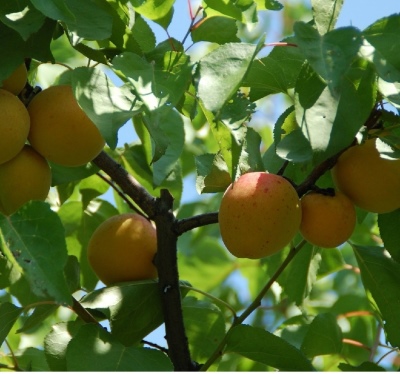
- Authors: K.K. Mullayanov, A.E. Pankratova, V.I. Putyatin, I. G. Zamyatina (South Ural Research Institute of Fruit and Vegetable and Potato)
- Year of approval: 1999
- Escapes: dark red, thin, straight, naked, many lentils
- Flowers: small, goblet
- Fruit weight, g: 16
- Fruit shape: rounded
- Fruit color: main - yellow, integumentary - anthocyanin, in the form of small dots
- Pulp color : light orange
- Pulp (consistency): medium density, juicy
- Fruit taste: sweet and sour
Not so long ago, apricot was considered only a southern culture, it was not very common in the gardens of central Russia, and it was very rare in the Urals and to the east. The Chelyabinsky early variety completely refutes this statement.
Breeding history
Chelyabinsk has long been a well-known center for breeding winter-hardy apricot varieties. Investigations in this direction were started here back in 1933, they are being successfully continued at the present time. So, the Chelyabinsk early was obtained on the basis of the South Ural Research Institute of Horticulture and Potato Growing. Scientists K. K. Mullayanov, I. G. Zamyatina, V. I. Putyatin, A. E. Pankratova worked on its creation, using free pollination of a Manchurian apricot seedling in 1981. It was possible to isolate a varietal seedling in 1986. In 1994, it was accepted for state variety testing, and in 1999 it was entered into the State Register for the Ural Region.
Description of the variety
The culture is a medium-sized tree, the rounded open crown of which is slightly raised, has both density and medium foliage. Thin straight shoots of a beautiful dark red tone, with strong branching, numerous protruding lenticels and protruding medium-sized buds extend from the trunk. Leaves are dark green, wrinkled. The leaf plates are rounded, sharp at the base, with an elongated pointed apex, rather large, with serrated edges.
The flowering culture is early, the cups with buds are pink, and the petals themselves are white, rounded. The flowers are small, the bowl of the flower is goblet. The pedicel is very short. Fruiting occurs mainly on bouquet branches and spurs.
Fruit characteristics
The fruits of the Chelyabinsk early are not very large, they are 25X25X28 mm in size, the average weight of apricots is 12-16 g. Rounded in shape, yellow in the main color, anthocyanin cover color in the form of small dots. The shade of the pulp is orange in light tones, the consistency is medium in density. The appearance of apricots was rated by experts at 4 points.
Taste qualities
A universal product. The apricots are juicy, sweet and sour. Their taste was rated 4.4 points by the tasting committee. Composition:
- sugar - 8.6%;
- dry matter - 12.4%;
- ascorbic acid - 8.1 mg / 100 g;
- carotene 3.1 mg / 100 g.
Ripening and fruiting
The culture bred by Chelyabinsk breeders begins to bear fruit in the 4th season. It belongs to the group of apricots with early maturity and flowering and ripening. The harvest will ripen in the 3rd decade of July.

Yield
The productivity of the culture is average. So, a medium-sized tree brings 15 kg of medium-sized, but tasty apricots.
Growing regions
The Chelyabinsk early is zoned for the Ural region, and this is the Republic of Bashkortostan, as well as the Kurgan, Orenburg, Chelyabinsk regions. In addition, it grows well in Western Siberia.
Self-fertility and the need for pollinators
Chelyabinsk early is partially self-fertile, therefore it needs pollinators. The Kichiginsky apricot is considered the best option for the pollinator.
Growing and care
Effective care of the crop in question implies traditional measures, including timely pruning, feeding, protection from diseases, insect pests. When cultivating the Chelyabinsk early apricot, it is important to find the right place for planting with high-quality drainage, preferably on a hill. Planting crops in the Urals is best done in early spring, since the growing season here is short. Over the summer, the seedling will have time to stretch out 50 cm, form a tree trunk, as well as growth buds. It is best to carry out planting activities in the last days of March or in early April - at this time in this region the soil should already thaw.
When cultivating an apricot tree, it is very important to carry out seasonal work on time. Accordingly, in the fall, you need to prepare the culture for winter. To protect the root system, it is recommended to dig a tree with a diameter of 1–2 m. Then sprinkle mulch of leaves, peat, humus with a thickness of at least 10–20 cm around the trunk. You can still put straw, reeds or corn on top. It is desirable to cover the trunk with burlap.



Disease and pest resistance
The culture in question is weakly affected by both fungal ailments and harmful insects.

Winter hardiness and the need for shelter
Chelyabinsk early is distinguished by excellent winter hardiness and frost resistance. As for such an indicator as drought resistance, it is average for the variety.































































